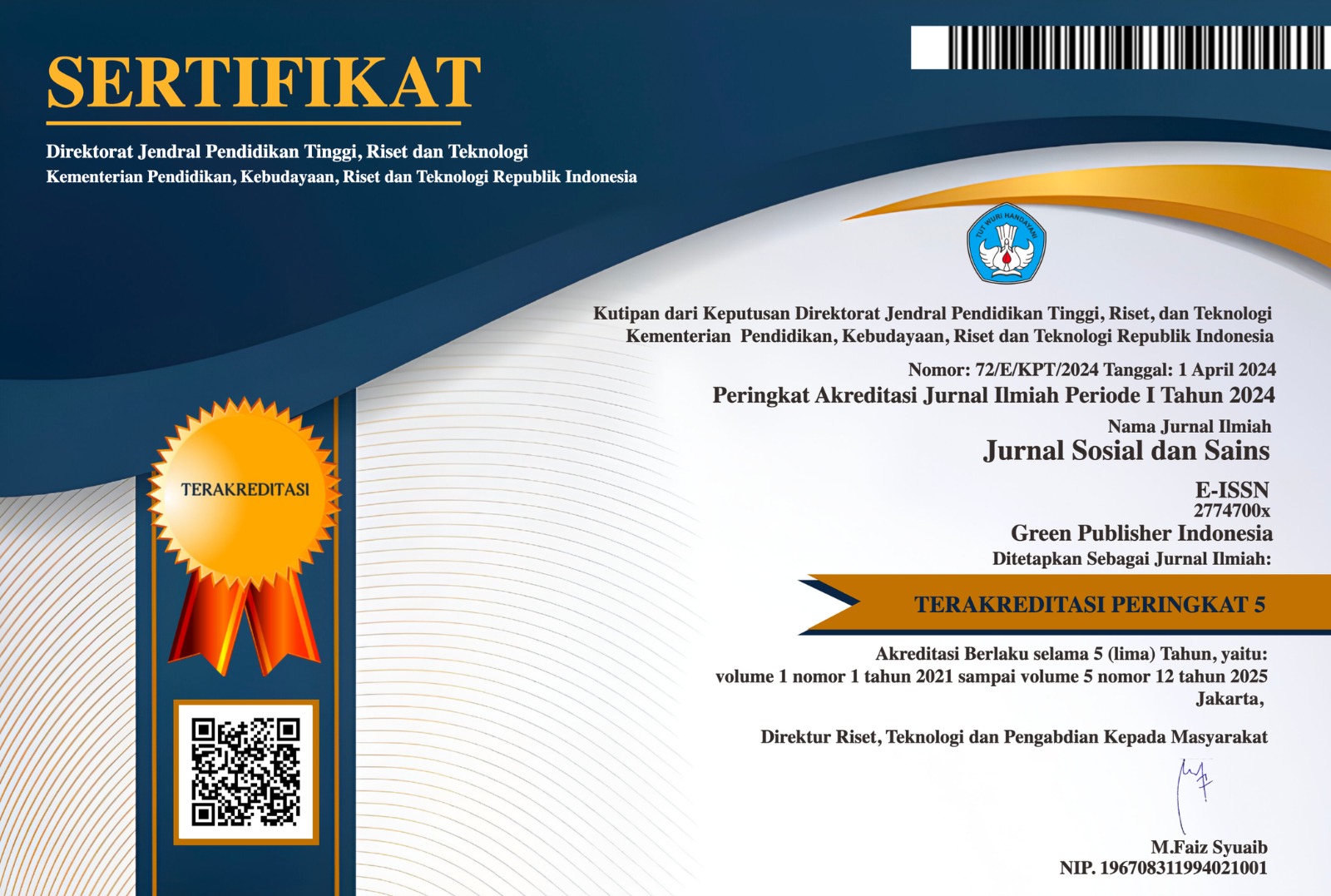Hubungan Antara Kadar Vitamin D Dengan Frekuensi Bangkitan Pada Pasien Epilepsi di Rumah Sakit Adam Malik
DOI:
https://doi.org/10.59188/jurnalsosains.v5i4.32154Keywords:
Epilepsi, Vitamin D, Frekuensi BangkitanAbstract
Tujuan penelitian ini untuk menilai hubungan antara kadar vitamin D dengan frekuensi bangkitan pada pasien epilepsi. Penelitian ini berupa analitik observasional dengan desain cross sectional, yang dilaksanakan di Instalasi Rawat Jalan Rumah Sakit Adam Malik mulai dari bulan Februari 2024 sampai Mei 2024. Data yang digunakan pada penelitian ini adalah data primer berupa hasil pemeriksaan laboratorium Kadar vitamin D diukur dengan pemeriksaan vitamin D25 (OH) total dan data dari rekam medis. Analisis univariat digunakan untuk mendapatkan karakteristik demografis dan klinis subjek penelitian. Analisis bivariat dengan uji korelasi pearson digunakan untuk menilai hubungan antara kadar vitamin D dengan frekuensi bangkitan. Hasil, Penelitian ini melibatkan 30 pasien epilepsi dengan Kadar vitamin D pada subjek penelitian ini mayoritas rendah, dengan rerata 22,97±6,41ng/mL yang terdiri dari insufisiensi (21-29 ng/mL) sebanyak 15 orang (50%), defisiensi (≤ 20 ng/mL) sebanyak 11 orang (36,7%), dan normal sebanyak 4 orang (13,3%). Tidak ditemukan hubungan yang signifikan antara kadar vitamin D dengan frekuensi bangkitan pada pasien epilepsi (p = 0,302). Tidak terdapat hubungan yang signifikan antara kadar vitamin D dengan frekuensi bangkitan pada pasien epilepsi.
References
Alfiani, R. F. (2019). Aspek Demografi Pada Pasien Epilepsi Di Smf Neurologi Rsud Dr. Soetomo Surabaya. Universitas Airlangga.
Aygun, H., Ayyildiz, M., & Agar, E. (2019). Effects of vitamin D and paricalcitol on epileptogenesis and behavioral properties of WAG/Rij rats with absence epilepsy. Epilepsy Research, 157, 106208. https://doi.org/https://doi.org/10.1016/j.eplepsyres.2019.106208
Beghi, E. (2020). The epidemiology of epilepsy. Neuroepidemiology, 54(2), 185–191.
DeGiorgio, C. M., Hertling, D., Curtis, A., Murray, D., & Markovic, D. (2019). Safety and tolerability of Vitamin D3 5000 IU/day in epilepsy. Epilepsy & Behavior, 94, 195–197. https://doi.org/https://doi.org/10.1016/j.yebeh.2019.03.001
Dewi, R. F. (2021). Hubungan Karakteristik Epilepsi dengan Kualitas Tidur. Universitas Sumatera Utara.
Haryanti, D. Y., Sundari, O. M., & Madani, R. F. (2022). Peningkatan kualitas hidup melalui physical and spiritual treatment pada pasien dengan epilepsi: studi kasus. Scientific Proceedings of Islamic and Complementary Medicine, 1(1), 77–86.
Hasibuan, M. H., Mahama, C. N., & Tumewah, R. (2016). Profil penyandang epilepsi di Poliklinik Saraf RSUP Prof. Dr. RD Kandou Manado periode Juli 2015 –Juni 2016. e-CliniC, 4(2).
Holick, M. F. (2017). The vitamin D deficiency pandemic: Approaches for diagnosis, treatment, and prevention. Rev Endocr Metab Disord, 18, 153–165.
Holló, A., Clemens, Z., & Lakatos, P. (2014). Epilepsy and Vitamin D. Int J Neurosci, 124(6), 387–393.
Kusumastuti, K. (2019). Pedoman tata laksana epilepsi.
Maryam, I. S., Wijayanti, I. A. S., & Tini, K. (2018). Karakteristik klinis pasien epilepsi di poliklinik saraf rsup sanglah periode januari–desember 2016. Callosum Neurology, 1(3), 91–96.
Nagarjunakonda, S., Amalakanti, S., Uppala, V., Rajanala, L., & Athina, S. (2015). Vitamin D in epilepsy: vitamin D levels in epileptic patients, patients on antiepileptic drug polytherapy, and drug-resistant epileptic sufferers. European Journal of Clinical Nutrition, 1–3.
Pendo, K., & DeGiorgio, C. M. (2016). Vitamin D3 for the treatment of epilepsy: basic mechanisms, animal models, and clinical trials. Front. Neurol., 7, 218.
Prasetyo, S., Sidharta, V. M., Wahyuningsih, K. A., Astiarani, Y., & Huh, I. S. (2022). The correlation between vitamin D intake and quality of life in the 17-35 age group. Media Kesehatan Masyarakat Indonesia, 18(3), 90–97.
Pudjonarko, D. (2018). Hubungan Kadar Vitamin D Serum Dengan Kualitas Hidup Pada Pasien Epilepsi.
Pulungan, A. J. N., Padraya, A. A., Faustine, F. A., Rahman, I., Tasya, R. M., & Kholinne, E. (2025). Peran Vitamin D Dalam Meningkatkan Performa Atlet. Jurnal Akta Trimedika, 2(2), 769–782.
Restuningtyas, F. R. (2019). Pengelompokan Penderita Epilepsi Berdasarkan Variabel Kualitas Hidup pada Komunitas Orang dengan Epilepsi. Institut Teknologi Sepuluh Nopember.
Salih, A. I., Mahmood, I. H., & Alkhaffaf, W. H. (2021). Effect of vitamin D level on quality of life in epileptic patients. J Health Sci, 44(06), 2979–2988.
Silva, B. A., Gross, C. T., & Gräff, J. (2016). The neural circuits of innate fear: detection, integration, action, and memorization. Learning & memory, 23(10), 544–555.
Tombini, M., Palermo, A., Assenza, G., Pellegrino, G., Benvenga, A., Campana, C., Naciu, A. M., Assenza, F., & Di Lazzaro, V. (2018). Calcium metabolism serum markers in adult patients with epilepsy and the effect of vitamin D supplementation on seizure control. Seizure, 58, 75–81. https://doi.org/https://doi.org/10.1016/j.seizure.2018.04.008
Downloads
Published
How to Cite
Issue
Section
License
Copyright (c) 2025 Ahmad Suheil Pulungan, Chairil Amin Batubara, Aida Fitri

This work is licensed under a Creative Commons Attribution-ShareAlike 4.0 International License.
Authors who publish with this journal agree to the following terms:
- Authors retain copyright and grant the journal right of first publication with the work simultaneously licensed under a Creative Commons Attribution-ShareAlike 4.0 International (CC-BY-SA). that allows others to share the work with an acknowledgement of the work's authorship and initial publication in this journal.
- Authors are able to enter into separate, additional contractual arrangements for the non-exclusive distribution of the journal's published version of the work (e.g., post it to an institutional repository or publish it in a book), with an acknowledgement of its initial publication in this journal.
- Authors are permitted and encouraged to post their work online (e.g., in institutional repositories or on their website) prior to and during the submission process, as it can lead to productive exchanges, as well as earlier and greater citation of published work.








